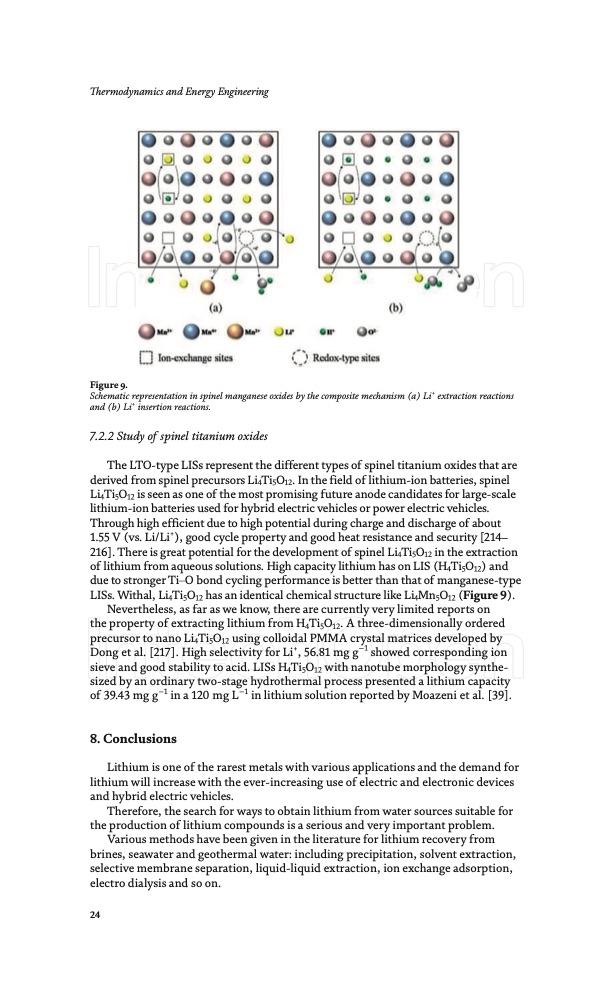
PDF Publication Title:
Text from PDF Page: 026
Thermodynamics and Energy Engineering Figure 9. Schematic representation in spinel manganese oxides by the composite mechanism (a) Li+ extraction reactions and (b) Li+ insertion reactions. 7.2.2 Study of spinel titanium oxides The LTO-type LISs represent the different types of spinel titanium oxides that are derived from spinel precursors Li4Ti5O12. In the field of lithium-ion batteries, spinel Li4Ti5O12 is seen as one of the most promising future anode candidates for large-scale lithium-ion batteries used for hybrid electric vehicles or power electric vehicles. Through high efficient due to high potential during charge and discharge of about 1.55 V (vs. Li/Li+), good cycle property and good heat resistance and security [214– 216]. There is great potential for the development of spinel Li4Ti5O12 in the extraction of lithium from aqueous solutions. High capacity lithium has on LIS (H4Ti5O12) and due to stronger Ti–O bond cycling performance is better than that of manganese-type LISs. Withal, Li4Ti5O12 has an identical chemical structure like Li4Mn5O12 (Figure 9). Nevertheless, as far as we know, there are currently very limited reports on the property of extracting lithium from H4Ti5O12. A three-dimensionally ordered precursor to nano Li4Ti5O12 using colloidal PMMA crystal matrices developed by Dong et al. [217]. High selectivity for Li+, 56.81 mg g−1 showed corresponding ion sieve and good stability to acid. LISs H4Ti5O12 with nanotube morphology synthe- sized by an ordinary two-stage hydrothermal process presented a lithium capacity of 39.43 mg g−1 in a 120 mg L−1 in lithium solution reported by Moazeni et al. [39]. 8. Conclusions Lithium is one of the rarest metals with various applications and the demand for lithium will increase with the ever-increasing use of electric and electronic devices and hybrid electric vehicles. Therefore, the search for ways to obtain lithium from water sources suitable for the production of lithium compounds is a serious and very important problem. Various methods have been given in the literature for lithium recovery from brines, seawater and geothermal water: including precipitation, solvent extraction, selective membrane separation, liquid-liquid extraction, ion exchange adsorption, electro dialysis and so on. 24PDF Image | Lithium Recovery from Seawater Salt Lake Brine

PDF Search Title:
Lithium Recovery from Seawater Salt Lake BrineOriginal File Name Searched:
IntechOpenSamadiyBookchapter.pdfDIY PDF Search: Google It | Yahoo | Bing
Product and Development Focus for Infinity Turbine
ORC Waste Heat Turbine and ORC System Build Plans: All turbine plans are $10,000 each. This allows you to build a system and then consider licensing for production after you have completed and tested a unit.Redox Flow Battery Technology: With the advent of the new USA tax credits for producing and selling batteries ($35/kW) we are focussing on a simple flow battery using shipping containers as the modular electrolyte storage units with tax credits up to $140,000 per system. Our main focus is on the salt battery. This battery can be used for both thermal and electrical storage applications. We call it the Cogeneration Battery or Cogen Battery. One project is converting salt (brine) based water conditioners to simultaneously produce power. In addition, there are many opportunities to extract Lithium from brine (salt lakes, groundwater, and producer water).Salt water or brine are huge sources for lithium. Most of the worlds lithium is acquired from a brine source. It's even in seawater in a low concentration. Brine is also a byproduct of huge powerplants, which can now use that as an electrolyte and a huge flow battery (which allows storage at the source).We welcome any business and equipment inquiries, as well as licensing our turbines for manufacturing.| CONTACT TEL: 608-238-6001 Email: greg@infinityturbine.com | RSS | AMP |